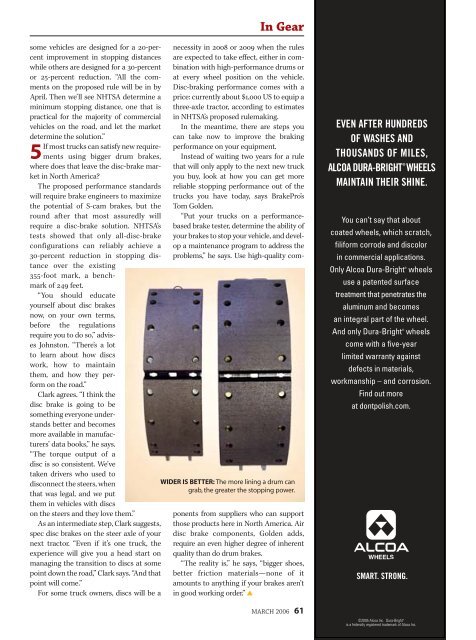Create successful ePaper yourself
Turn your PDF publications into a flip-book with our unique Google optimized e-Paper software.
some vehicles are designed for a 20-percent<br />
improvement in stopping distances<br />
while others are designed for a 30-percent<br />
or 25-percent reduction. “All the comments<br />
on the proposed rule will be in by<br />
April. Then we’ll see NHTSA determine a<br />
minimum stopping distance, one that is<br />
practical for the majority of commercial<br />
vehicles on the road, and let the market<br />
determine the solution.”<br />
5If most trucks can satisfy new requirements<br />
using bigger drum brakes,<br />
where does that leave the disc-brake market<br />
in North America?<br />
The proposed performance standards<br />
will require brake engineers to maximize<br />
the potential of S-cam brakes, but the<br />
round after that most assuredly will<br />
require a disc-brake solution. NHTSA’s<br />
tests showed that only all-disc-brake<br />
configurations can reliably achieve a<br />
30-percent reduction in stopping distance<br />
over the existing<br />
355-foot mark, a benchmark<br />
of 249 feet.<br />
“You should educate<br />
yourself about disc brakes<br />
now, on your own terms,<br />
before the regulations<br />
require you to do so,” advises<br />
Johnston. “There’s a lot<br />
to learn about how discs<br />
work, how to maintain<br />
them, and how they perform<br />
on the road.”<br />
Clark agrees. “I think the<br />
disc brake is going to be<br />
something everyone understands<br />
better and becomes<br />
more available in manufacturers’<br />
data books,” he says.<br />
“The torque output of a<br />
disc is so consistent. We’ve<br />
taken drivers who used to<br />
disconnect the steers, when<br />
that was legal, and we put<br />
them in vehicles with discs<br />
on the steers and they love them.”<br />
As an intermediate step, Clark suggests,<br />
spec disc brakes on the steer axle of your<br />
next tractor. “Even if it’s one truck, the<br />
experience will give you a head start on<br />
managing the transition to discs at some<br />
point down the road,” Clark says. “And that<br />
point will come.”<br />
For some truck owners, discs will be a<br />
<strong>In</strong> <strong>Gear</strong><br />
necessity in 2008 or 2009 when the rules<br />
are expected to take effect, either in combination<br />
with high-performance drums or<br />
at every wheel position on the vehicle.<br />
Disc-braking performance comes with a<br />
price: currently about $1,000 US to equip a<br />
three-axle tractor, according to estimates<br />
in NHTSA’s proposed rulemaking.<br />
<strong>In</strong> the meantime, there are steps you<br />
can take now to improve the braking<br />
performance on your equipment.<br />
<strong>In</strong>stead of waiting two years for a rule<br />
that will only apply to the next new truck<br />
you buy, look at how you can get more<br />
reliable stopping performance out of the<br />
trucks you have today, says BrakePro’s<br />
Tom Golden.<br />
“Put your trucks on a performancebased<br />
brake tester, determine the ability of<br />
your brakes to stop your vehicle, and develop<br />
a maintenance program to address the<br />
problems,” he says. Use high-quality com-<br />
WIDER IS BETTER: The more lining a drum can<br />
grab, the greater the stopping power.<br />
ponents from suppliers who can support<br />
those products here in North America. Air<br />
disc brake components, Golden adds,<br />
require an even higher degree of inherent<br />
quality than do drum brakes.<br />
“The reality is,” he says, “bigger shoes,<br />
better friction materials—none of it<br />
amounts to anything if your brakes aren’t<br />
in good working order.” ▲<br />
MARCH 2006 61<br />
���� ����� ��������<br />
�� ������ ���<br />
��������� �� ������<br />
����� ����������� �<br />
������<br />
�������� ����� ������<br />
�������������������������<br />
������������������������������<br />
��������������� ��� ��������<br />
�� ���������� �������������<br />
���� ����� ����������� �<br />
�������<br />
�����������������������<br />
��������� ���� ���������� ���<br />
�������� ������������<br />
�������������������������������<br />
�������������������� �<br />
��������<br />
���������������������<br />
���������������� �������<br />
������� �� ����������<br />
�����������������������������<br />
���� ��� ����<br />
�� ���������������<br />
������ �������<br />
����� ����� ���� ����������� �<br />
�� � ��������� ���������� ��������� �� ����� ����



